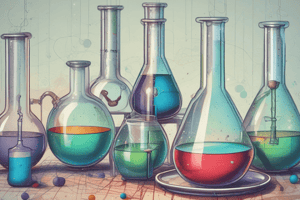Podcast
Questions and Answers
Faktor apa yang dapat mempengaruhi konsentrasi larutan?
Faktor apa yang dapat mempengaruhi konsentrasi larutan?
Perubahan suhu, perubahan tekanan, sifat pelarut, keberadaan spesies terlarut lainnya
Apa yang mempengaruhi kelarutan zat terlarut dalam pelarut?
Apa yang mempengaruhi kelarutan zat terlarut dalam pelarut?
Sifat pelarut seperti polaritas, kemampuan ikatan hidrogen, dan karakteristik ionisasi.
Bagaimana perubahan suhu dapat memengaruhi konsentrasi larutan?
Bagaimana perubahan suhu dapat memengaruhi konsentrasi larutan?
Suhu yang lebih tinggi dapat meningkatkan laju pergerakan partikel, potensial meningkatkan kelarutan beberapa zat terlarut.
Apa dampak keberadaan spesies terlarut lainnya dalam larutan?
Apa dampak keberadaan spesies terlarut lainnya dalam larutan?
Apakah tekanan atmosfir dapat memengaruhi konsentrasi larutan?
Apakah tekanan atmosfir dapat memengaruhi konsentrasi larutan?
Mengapa penting memahami konsep konsentrasi dalam kimia?
Mengapa penting memahami konsep konsentrasi dalam kimia?
Apa pengaruh peningkatan luas permukaan padatan terhadap pelarutan?
Apa pengaruh peningkatan luas permukaan padatan terhadap pelarutan?
Apa yang dimaksud dengan konsentrasi massa?
Apa yang dimaksud dengan konsentrasi massa?
Apa yang dimaksud dengan molaritas?
Apa yang dimaksud dengan molaritas?
Apa pengaruh konsentrasi terhadap laju reaksi?
Apa pengaruh konsentrasi terhadap laju reaksi?
Mengapa konsentrasi penting dalam menentukan batas kelarutan?
Mengapa konsentrasi penting dalam menentukan batas kelarutan?
Apa aplikasi umum dari larutan konsentrat?
Apa aplikasi umum dari larutan konsentrat?
Flashcards are hidden until you start studying
Study Notes
Concentration in solutions refers to the amount of solute dissolved into a solvent, usually measured by mass concentration. This concept is fundamental to understanding various chemical processes, reactions, and their associated properties. In this context, we will discuss the factors influencing concentration, methods used to measure it, its importance, and examples of concentrated solutions.
Factors Affecting Solution Concentration
There are several factors that affect the concentration of a solution, including:
-
Temperature changes: Higher temperatures can increase the rate at which particles move, potentially increasing the solubility of some solutes. However, temperature also affects the boiling point of water and other volatile components, which may require adjustments in experimental procedures.
-
Pressure changes: Atmospheric pressure can influence the solubility or vapor pressure of gases and vapors in aqueous solutions.
-
Nature of the solvent: Different solvents have varying degrees of polarity, hydrogen bonding ability, and ionization characteristics, which can significantly impact the solubility of different solutes.
-
Presence of other dissolved species: Additional solutes present in a solution may compete with the primary solute for available solvent molecules, leading to altered solubility and concentration.
-
Surface area: Increasing the surface area of a solid in contact with solvent increases the rate at which dissolution occurs, potentially leading to higher concentrations.
Measuring Solution Concentration
There are two primary methods used to measure solution concentration:
-
Mass concentration: Direct mass measurement involves weighing the solute particle before and after adding it to a known volume of solvent, allowing calculation of the initial and final masses. Mass concentrations are typically expressed in grams per liter (g/L) or milligrams per liter (mg/L).
-
Molarity: Molar solutions contain exactly one molecule of solute per liter of solvent, while molality expresses the number of moles of solute per kilogram of solvent. These measurements require knowledge of the molecular weight of the solute and the volume or mass of the solvent.
Additionally, there are indirect methods of measuring concentration, such as spectroscopic techniques like ultraviolet-visible (UV-Vis) spectrophotometry and nuclear magnetic resonance (NMR) spectroscopy, which involve analyzing light absorption patterns or magnetic properties of atoms to infer concentration.
Importance of Solution Concentration
Concentration plays a vital role in determining many chemical phenomena, including:
-
Reaction rates: Higher concentrations generally lead to faster reaction rates, although this relationship may vary depending on the specific reaction mechanism.
-
Solubility limits: Higher concentrations may exceed the solubility limit of a solute in a solvent, leading to precipitation or phase separation.
-
Equilibrium: Concentration influences the equilibrium constant (K) of chemical reactions, with higher concentrations generally favoring the formation of products.
-
Thermodynamics: The concentration of a solution can affect the enthalpy (heat content), entropy (degree of disorder), and Gibbs free energy (maximum reversible work) of a system.
Examples of Concentrated Solutions
Concentrated solutions are commonly found in various applications, such as:
-
Electrolytes: Highly concentrated solutions of inorganic salts are used in electrolytes, which are essential for conducting electricity in batteries, electroplating, and other electrochemical processes.
-
Polymers: Highly concentrated solutions of polymers, such as polyethylene glycol (PEG), are used as solvents in applications like tissue engineering and drug delivery systems.
-
Acids and bases: Concentrated solutions of acids (e.g., sulfuric acid) and bases (e.g., sodium hydroxide) are widely utilized in industrial processes, such as paper production and chemical synthesis.
In summary, concentration in solutions is a critical factor in understanding and predicting chemical phenomena. By considering the factors influencing concentration, measuring concentration accurately, recognizing the importance of concentration in various contexts, and exploring examples of concentrated solutions, researchers and practitioners can better navigate the complex world of chemistry and harness its transformative potential.
Studying That Suits You
Use AI to generate personalized quizzes and flashcards to suit your learning preferences.




